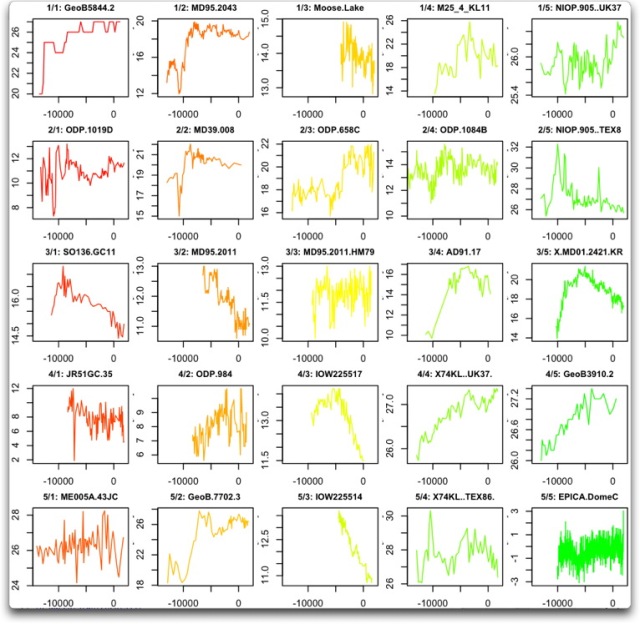Now you're just winging it and IGNORING the science as Marcott explained it to you.. Doesn't matter to a filter whether the "wiggle" is UP or Down or both. It be attenuated and it's rise/fall times will be reduced by the bandwidth of the filter applied. When you are trying to merge ice cores, mudbug shells and tree rings, they all have different sampling points and sampling rates. To MERGE these in data prep --- your best resolution is closer to the WORSE proxies than the good ones and you HAVE to filter heavily..
When Marcott says that events less than 300 yrs are INVISIBLE in his work he means it.. PLEASE don't wing it. I might end up liking you better...
I've already told you -- might have SHOWED you --- that there are INDIVIDUAL PROXIES --- that SHOW transistions like ours all THRU this interglacial period. Lemme post this AGAIN for you below. The problem comes in because of the attempt to take a sparse number of mudbugs, tree rings, and ice cores from different parts of world and PRETEND you have a temperature record as accurate as the DEVIOUSLY tacked on modern thermometer record..
Here's a start -- I've clipped many others...
Ice cores and climate change - Publication - British Antarctic Survey
Abrupt climate changes
The climate changes described above were huge, but relatively gradual. However, ice cores have provided us with evidence that abrupt changes are also possible. During the last glacial period, Greenland experienced a sequence of very fast warmings (see Fig. 5 overleaf). The temperature increased by more than 10°C within 40 years. Other records show us that major changes in atmospheric circulation and climate were experienced all around the northern hemisphere. Antarctica and the Southern Ocean experienced a different pattern, consistent with the idea that these rapid jumps were caused by sudden changes in the transport of heat in the ocean. At this time, there was a huge ice sheet (the Laurentide) over northern North America. Freshwater delivered from the ice sheet to the North Atlantic was able periodically to disrupt the overturning of the ocean, causing the transport of tropical heat to the north to reduce and then suddenly increase again. While this mechanism cannot occur in the same way in today’s world, it does show us that, at least regionally, the climate is capable of extraordinary changes within a human lifetime – rapid switches we certainly want to avoid experiencing.

Go compare that to the GLOBAL hockeystick chart (about post 371) that you shoved at us.. Shows NONE of the 2 - 10 degC changes that this INDIVIDUAL proxy study does..
UNPRECENDENTED --- my ass...

*sigh* You ARE married to blogs arent you?
Lets just go back to Marcotts original paper, shall we?
What does the abstract say? (my emphasis)
A Reconstruction of Regional and Global Temperature for the Past 11,300 Years
"Surface temperature reconstructions of the past 1500 years suggest that
recent warming is unprecedented in that time. Here we provide a broader perspective by reconstructing regional and global temperature anomalies for the past 11,300 years from 73 globally distributed records. Early Holocene (10,000 to 5000 years ago) warmth is followed by ~0.7°C cooling through the middle to late Holocene (<5000 years ago), culminating in the coolest temperatures of the Holocene during the Little Ice Age, about 200 years ago. This cooling is largely associated with ~2°C change in the North Atlantic. Current global temperatures of the past decade have not yet exceeded peak interglacial values but are warmer than during ~75% of the Holocene temperature history.
Intergovernmental Panel on Climate Change model projections for 2100 exceed the full distribution of Holocene temperature under all plausible greenhouse gas emission scenarios."
This isnt some random paragraph in the discussion. Its the abstract - the conclusion.
And what does Marcott himself say about the study and how extreme the future projected warming will be? Lets pull up the interview that you posted and see (since you seem to hang on his words):
"Indeed, if any of the six emission scenarios considered by the IPCC that are shown on Figure 3 are followed, future global average temperatures, as projected by modeling studies, will likely be well outside anything the Earth has experienced in the last 11,300 years, as shown in Figure 3 of our study."
Response by Marcott <i>et al</i>.
Now go run back to your professional denier blogs and find out what you're supposed to say now.









